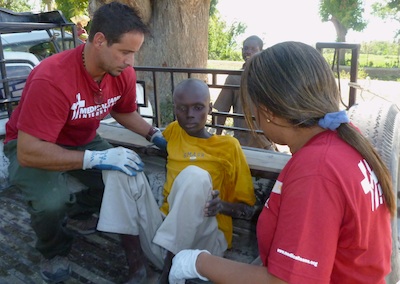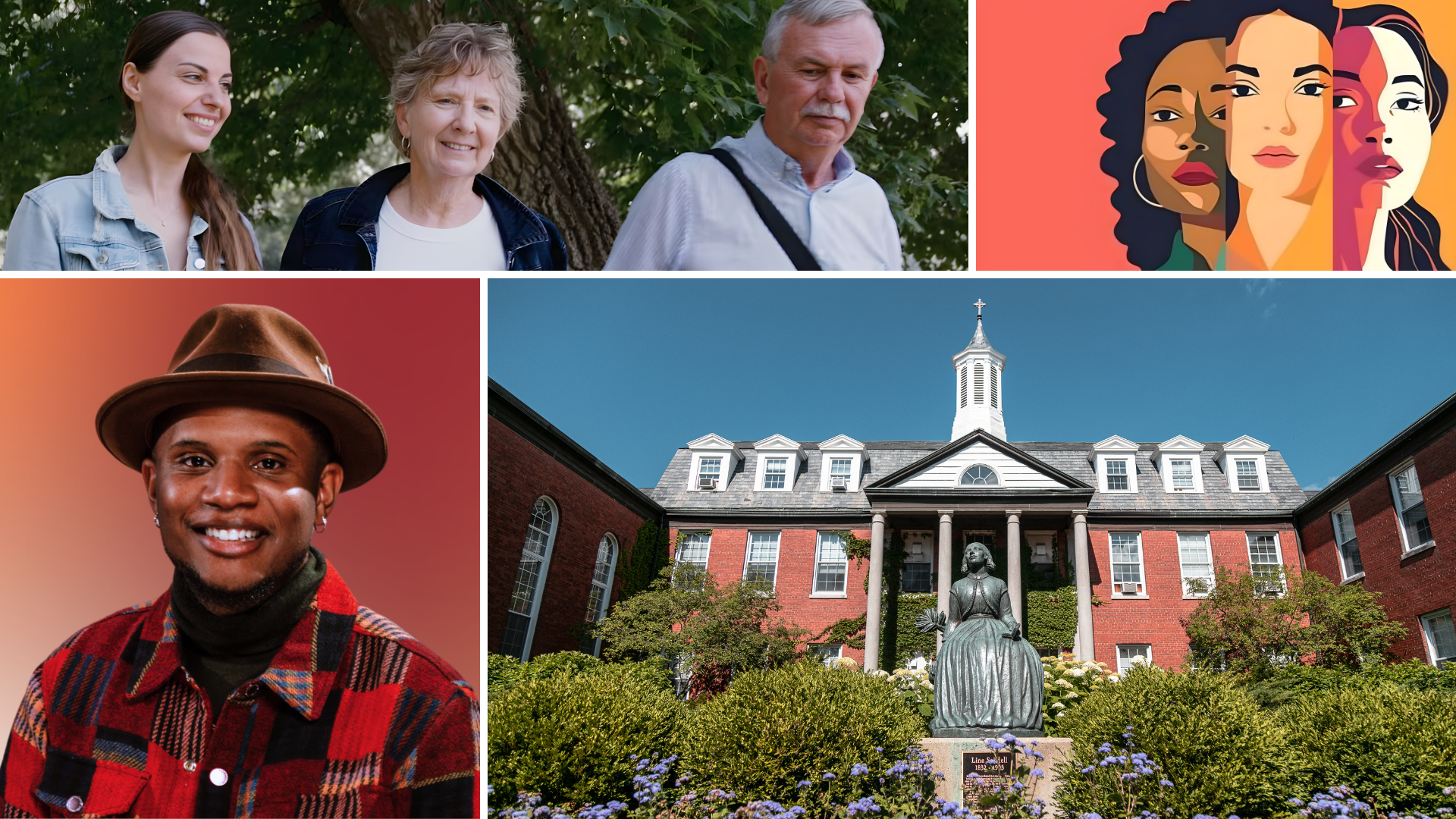PORT-AU-PRINCE, HAITI (March 18, 2011) – Editor’s note: This report contains a collection of notes taken from the reporter’s notebook. It is part of a week-long series of articles written by Stan Friedman, news editor for Covenant News Service, who spent five days accompanying a five-member medical team from the United States providing care to Haiti residents during a two-week volunteer mission.
By Stan Friedman
Haitian Nurse Inspires Ministry Team
Volunteers at the Medical Teams International clinic in Port-au-Prince gave hope to the Haitians who worked alongside them as well as to the patients.
 A Haitian nurse named Lisa, who translated for Detroit pediatrician Mary Hakim, had experienced her own tragedy a year before the earthquake when someone shot and killed her father. He had been a well-loved physician in the community.
A Haitian nurse named Lisa, who translated for Detroit pediatrician Mary Hakim, had experienced her own tragedy a year before the earthquake when someone shot and killed her father. He had been a well-loved physician in the community.
Then the earthquake brought her neighborhood literally crashing to the ground, killing many of her friends and neighbors. When the cholera epidemic hit, she worked tirelessly to save people who fell victim to the disease.
Too often, she and other medical personnel were unable to stop the course of the disease for people who arrived at the clinic too late and died of dehydration.
Lisa remains determined to help the people of her country. As Hakim treated patients, she turned those moments into teaching opportunities for her translator, offering her a unique kind of education.
“It seems that her spirit has lifted since working with us,” Claudine Mamo, a nurse from Detroit, wrote to friends. Mamo also was inspired by the translator, adding that despite being surrounded by tragedy, “Lisa has a wonderful faith in the Lord.”
Woman Encouraged to Pursue Her Dream
Matalia, a woman who assisted the team, dreams of being a schoolteacher because of her love for children. But she doubts that dream will come true because the cost of her own education would be too great.
The team suggested she start teaching children at the clinic site after it closed each day. Matalia could offer the children education they might not receive otherwise, they told her. Matalia loved the idea, and the team promised to buy the necessary supplies so she could start teaching classes.
Presence of Volunteer Groups Apparent
That there are numerous non-governmental organizations (NGOs) working here – reportedly more than 12,000 are registered – is evident as soon as a visitor leaves the Port-au-Prince airport. People waiting to pick up the new arrivals hold up signs identifying their organizations – World Vision, a Lutheran relief organization, a Mennonite organization, Baptists, as well as plenty of secular organizations.
Tent Cities Stretch for Miles
More than one million people are believed to be living in tent cities. The tents stretch for miles. But there also are clusters that fill any available pocket within Port-au-Prince. Some places may have no more than 30 tents.
Not All of Haiti is Devastated
Port-au-Prince looks much like areas of Germany following the bombings during World War II. It is a city of rubble. Dave Husby and others say there has been significant progress in moving the rubble. However, it is difficult to fathom what it must have been like before.
Haitians want visitors to know that most of their nation does not look like Port-au-Prince. The rural areas are gorgeous and lush. Haitian people are eager to work together to make a better future. Still, they have a lot to overcome. They must learn better agricultural techniques and find markets. Flooding still is a major problem due to unregulated deforestation.
Duvalier’s Detainment Spurs Early Departure
The flight on which Dave Husby, director of Covenant World Relief, and I were traveling back to the United States was scheduled to depart at 4 p.m. We were talking with staff at the Haiti headquarters for World Relief International around 11:30 a.m. that morning when we learned that deposed President Jean-Claude Duvalier had been taken into custody less than an hour earlier. Cognizant of the protests that erupted in December, we decided to leave immediately – as soon as our driver finished his lunch.
Our fears of riots breaking out were eased somewhat when we saw no additional United Nations vehicles on the road and observed Haitian police standing around talking. We weren’t sure people had heard the news yet, but we did see people tuned to their radios. I couldn’t understand the Creole spoken by the newscaster on the radio in our car, but did hear “Duvalier” every third or fourth sentence.
History Doesn’t Repeat Itself at Terminal
Last November two members of Redwood Covenant Church escaped through an airport terminal door to their waiting plane just as a mob protesting election results forced its way into the building – click here to read that report. I tried to imagine what it must have been like as my fellow passengers and I walked quietly through the same door just months later.
Getting Around Haiti – A Jarring Experience
I will try to never complain about Chicago potholes again. Most of Port-au-Prince’s roads are little more than wide gravel, pockmarked alleys. They jar a passenger’s body from side to side, forward and back, as well as up and down. More than once I hit my head on the vehicle’s ceiling or passenger window. I told team member Tom Spethmann, a physician, that I would need an examination later that evening. I was sure my internal organs had been shaken loose and displaced.
I had no idea how our drivers knew where to go. Many of the streets are not marked. Richard Goutier, one of the people who helped drive the mission team and translated at the clinics, said he identifies landmarks where he is supposed to turn.
Riding in a vehicle on Haitian streets was easily one of the most frightening experiences of my life. There are few stop signs at intersections. Most of the drivers don’t have licenses. Driving in the opposite lane is common, especially when the road is cratered. Cars zip in and out of traffic even in sections crowded with pedestrians.
Alex Areces, MTI’s assistant director for Haiti, said it is important to drive in a controlled, offensive (as opposed to defensive) manner. “People expect you to drive offensively,” he explained. “Accidents happen when you drive defensively because they don’t expect you to do that.”
According to my team members who have traveled around the world, this is normal for developing nations. Compared to some places, driving in Haiti was easy, they say. Still, the Americans I talked with said there was no way they would drive in the city – ever.
Unemployment Rate Less Than Reported
Workers with Medical Teams International and World Relief International say reports of an 80 percent unemployment rate are exaggerated because it measures only the number of people who work at companies and other formal businesses. Much of Haiti is a cash economy, with people providing services such as auto repair or small street shops. They still make little money, however. Entrepreneurs must make enough to live for that day and possibly the next. Although Canaan has 30,000 residents, it is fairly quiet during the day as people leave the area to scrounge what they can before returning home around 4 p.m. It’s clear that Haitians are resilient.
Businesses Springing Up in Canaan
Small shops – from food markets to an Internet café near the top of the hills – already are starting. People use the Internet to connect with relatives in the United States and elsewhere. Money sent from the relatives helps the Haitians survive. Tiny Western Union offices located around Port-au-Prince are always busy.
Guard Living in Tent Protects Clinic
Every night, a young man named Daniel sleeps in a tent behind the clinic to make sure it is not vandalized and that no one tries to set up house in the structure. This is not the safest job.
He is connected with the church led by David Guillimere, who travels several times a week to Canaan to share the gospel. Daniel is quiet, polite, and eager to be useful wherever he can. He won’t let volunteers carry tables, chairs, or other supplies, if he can help it.
When I was trying to shoot video and take pictures looking down to the inside of the clinic, he grabbed a homemade ladder and set it up for me. I had not known he was doing this until he showed me it was in place. He loves Jesus. He humbled me.
To read earlier stories, click on the links below:














